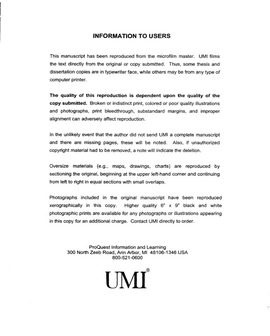| dc.contributor.advisor | McInerney, Michael J., | en_US |
| dc.contributor.author | Elshahed, Mostafa Samir. | en_US |
| dc.date.accessioned | 2013-08-16T12:18:18Z | |
| dc.date.available | 2013-08-16T12:18:18Z | |
| dc.date.issued | 2001 | en_US |
| dc.identifier.uri | https://hdl.handle.net/11244/335 | |
| dc.description.abstract | Overall, the work in this dissertation contributes to our understanding of anaerobic biodegradation pathways, the role of syntrophic interactions in substrates degradation, and demonstrates a novel benzoate fermentation ability in S. aciditrophicus. (Abstract shortened by UMI.) | en_US |
| dc.description.abstract | The metabolism of benzoate, cyclohex-1-ene carboxylate and cyclohexane carboxylate by Syntrophus aciditrophicus in coculture with hydrogen-using microorganisms was studied. Cocultures of S. aciditrophicus and Methanospirillum hungatei readily metabolized cyclohexane carboxylate and cyclohex-1-ene carboxylate at a rate slightly faster than that for benzoate. These results suggest that a unique ring-reduction mechanism operates in S. aciditrophicus which is probably imposed by energetic constraints encountered during syntrophic benzoate metabolism. | en_US |
| dc.description.abstract | The anaerobic degradation of monoaromatic compounds was studied under a variety of terminal electron-accepting conditions to test the susceptibility to and possible metabolic pathways involved in toluic acids degradation under methanogenic and sulfate-reducing conditions, to determine the pathway for benzoate degradation in the syntrophic bacterium Syntrophus aciditrophicus , as well as to determine whether toluene degradation under sulfate-reducing conditions is dependent on interspecies hydrogen transfer. All toluic acid isomers were degraded under sulfate-reducing conditions, with m-toluate degradation occurring at the fastest rate. Benzoate, isophthalate, and m-carboxybenzylsuccinate were detected as transient intermediates in m-toluate-degrading, sulfate-reducing enrichments. All three toluate isomers were also degraded under methanogenic conditions with phthalic, isophthalic and terephthalic acids transiently accumulating in the culture supernatants of o-, m- and p-toluate methanogenic cultures, respectively. o-Carboxybenzaldehyde was detected in the culture supernatant of o-toluate methanogenic enrichments. These results show that the biodegradation of toluic acids is initiated at the methyl group under both electron-accepting conditions and that the formation of m-carboxybenzylsuccinic acid is an early step in m-toluate degradation under sulfate-reducing conditions. | en_US |
| dc.description.abstract | S. aciditrophicus also metabolized benzoate in pure culture in the absence of hydrogen-utilizing partners or terminal-electron acceptors. S. aciditrophicus produced approximately 0.5 mol of cyclohexane carboxylate and 1.5 mol of acetate per mol of benzoate when grown in pure cultures compared to 3 mol of acetate and 0.75 mol of methane per mol of benzoate in coculture with M. hungatei. | en_US |
| dc.format.extent | xv, 138 leaves : | en_US |
| dc.subject | Aromatic compounds Biodegradation. | en_US |
| dc.subject | Biology, Microbiology. | en_US |
| dc.subject | Anaerobic bacteria. | en_US |
| dc.subject | Benzoates. | en_US |
| dc.subject | Hydrocarbons Biodegradation. | en_US |
| dc.title | Peripheral and central pathways involved in the biodegradation of monoaromatic compounds under anaerobic conditions. | en_US |
| dc.type | Thesis | en_US |
| dc.thesis.degree | Ph.D. | en_US |
| dc.thesis.degreeDiscipline | Department of Microbiology and Plant Biology | en_US |
| dc.note | Adviser: Michael J. McInerney. | en_US |
| dc.note | Source: Dissertation Abstracts International, Volume: 62-05, Section: B, page: 2173. | en_US |
| ou.identifier | (UMI)AAI3014514 | en_US |
| ou.group | College of Arts and Sciences::Department of Microbiology and Plant Biology | |
